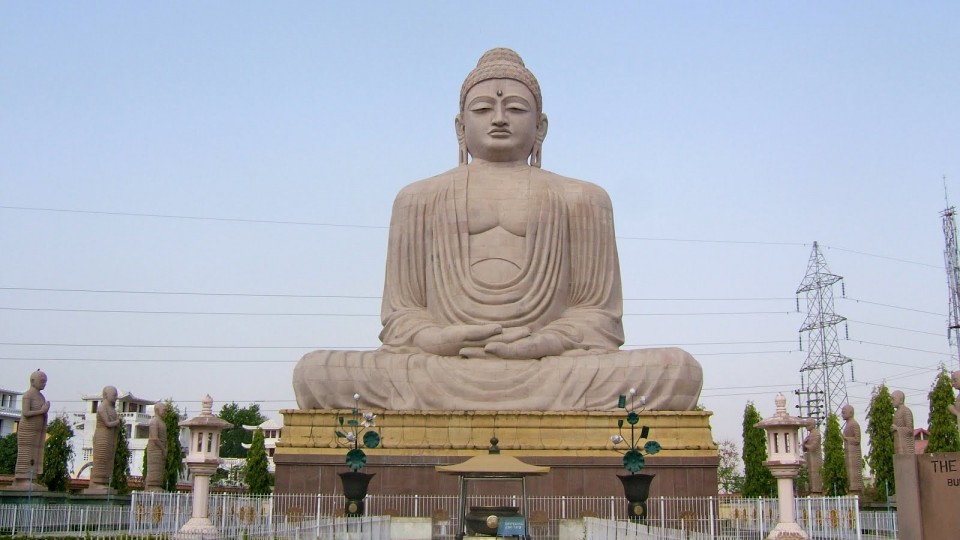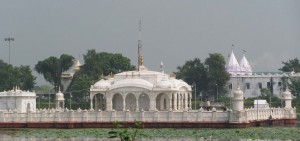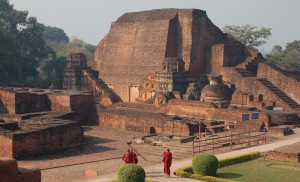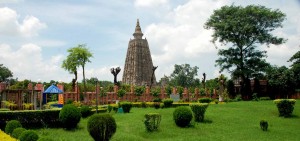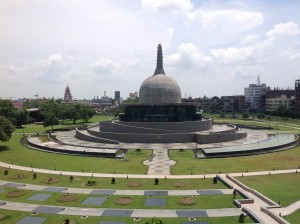Top Attractions
See[edit]
Ahirauli (Buxur) About 5 km north-east of Buxur, this village has a temple of Devi Ahilya. According to the local tradition it dates back to the pre historic ages. Legend is that, Ahilya was transformed into stone as a result of curse of her husband, Rishi Gautam and she could be redeemed only when lord Ram Chandra visited her place.
Bari Dargah (Bihar Sharif, Nalanda) This is headquarters of Nalanda district that lies 30 km South of Bakhtiarpur on NH-31. This is also a railhead on the Bakhtiarpur Rajgir branch line of the Eastern Indian Railway. This town is known as Bihar Sharif, owing to its many Muslim tombs that still retain traces of its former importance as a Muslim pilgrimage. There is a hill called Pir Pahari, about 1 m to the northwest of the town. At its summit is the dargah or mausoleum of the Saint Mallik Ibrahim Bayu, round which are tem smaller tombs. It is a brick structure surmounted by a dome and bears inscriptions showing that the saint died in 1353. Another great dargah is that of Mokhdum Shah Sharif ud-din, also called Makhdum-ul-Mulk, died here in 1379; the inscription over the entrance shows that his tomb was built in 1569. This tomb, which stands on the south bank of the river, is held in great veneration by the local Muslims, who assemble here on the 5th day of Sawan to celebrate the anniversary of his death. The Chhoti Dargah is the shrine of Badruddin Badr-I-Alam, famous saint who died here in 1440.
Bhimbandh (Munger) It is 56 km from Munger, 20 km from Jamui Railway Station and 200 km from Patna Airport. Bhimbandh Wild Life Sanctuary is located in the south west of Munger District. The forests cover an area or 681.99 km2 on the hills and undulating tract of Kharagpur Hills.
Bodh Gaya Near the holy city of Gaya, the Buddha attained enlightenment. The tree that had sheltered him came to be known as the Bodhi tree and the place Bodhgaya. Today Bodhgaya, an important place of pilgrimage, has a number of monasteries, some of them established by Buddhists of Japan, Thailand, Myanmar, Sri Lanka, etc.
Janki Temple (Sitamarhi) This temple is traditionally considered to be the birthplace of Sita or Janki, the daughter of king Janak. This temple, however seems to have been built about 100 years ago.
Kakolat (Nawada) It is a waterfall in Gobindpur police-station, about 21 miles away from Nawada. After going 9¼ miles from Nawada on Ranchi Road, a solid road known as Gobindpur—Akbarpore Road diverts from there. Just below the fall there is a deep reservoir natural in character. The fall is about 150 to 160 feet, from the ground level. The scene is panoramic due to all-round green forest area, which is very pleasant to the eyes. A legend is prevalent that in Treta Yuga a king named was cursed by a rishi and had to take the shape of a python and lived here. The place was visited by the great Pandavas during their exile and the accursed king got salvation from the damnation. The king after getting rid of the curse proclaimed that one who would bathe in the waterfall will not take the yoni of snake and that is why a large number of people from far and near bathe in the river. A big fair is held on the occasion of bishua or Chait Shankranti.
Kesaria This Stupa is in fact one of the many memorable stupa remarkable event in the life of Buddha. Kesaria has a lofty brick mound capped by a solid brick tower of considerable size, which it self is the remain of a Buddhist Stupa. The mound is a ruin with a diameter of 68 feet at its base and a total height of 5½ ft. It used to be crowned by a pinnacle which must have stood 80 or 90 ft above the ground. General Cunningham dated this monument to 200 to 700 CE, and held that it was built upon the ruins of a much older and larger Stupa. It is the highest Stupa found in the country with a height of about 104 ft (32 m) from the base.
Maner Sharif (Patna, Maner) It is a large village of historical antiquities, situated in the extreme north west of Danapur Sub-division, about 32 km west of Patna on Patna-Arrah Highway. In the early ages Maner was a centre of learning and it is said that grammarian Panini, and also Bararuchi, lived and studied here. Maner contains two well-known Muslim tombs, that of Shah Daulat or Makhdum Daulat, known as Chhoti Dargah, and the other that of Sheikh Yahia Maneri or Makhdum Yahia, called the Bari Dargah. Makhdum Daulat died at Maner in 1608, and Ibrahim Khan, Governor of Bihar and one of the saint's disciples completed the erection of his mausoleum in 1616. The building is exceptionally fine one, with walls containing carvings of great delicacy and high finish. A great dome crowns it, and the ceiling is covered with carved inscriptions from the Quran. Every detail of it is characteristic of the architecture of Jehangir's region, and it is by far the finest monument of the Mughals in Eastern India. Inside the compound there is a mosque also built by Ibrahim Khan in 1619, whiles a fine gateway bearing an older inscription corresponding to 1603–01, and affords access to the north. The tomb of Yahia Maneri lies in a mosque walls and ghats, and pillared porticos jutting out into it, which is connected with the old bed of the River Sone by a tunnel 400 ft long.
Motihari (East Champaran) Motihari was to the first laboratory of Gandhian experiment in Satyagraha and probably it will not be very incorrect to say that is has been the spring board for India's independence. Champaran district generated a wave of enthusiasm and inspiration to the people who were thirsting for a selfless and saintly leader. The technique followed by Gandhiji in Champaran was what attained later on the name of Satyagraha.
Nalanda A great centre of Buddhist learning, Nalanda came into prominence around the 5th century BCE and was a flourishing university town with over 10,000 scholars and an extensive library.
Patna once called Patliputra the capital of Bihar, is among the world's oldest capital cities with unbroken history of many centuries as imperial metropolis of the Mauryas and Guptas imperial dynasties.
Pawapuri In Pawapuri, or Apapuri, 38 km from Rajgir and 90 kilometres from Patna, all sins end for a devout Jain. Lord Mahavira, the final tirthankar and founder of Jainism, breathed his last at this place.
Rajgir Rajgir, 103 km from Patna, was the ancient capital of Magadha Empire. Lord Buddha often visited the monastery here to meditate and to preach. Rajgir is also a place sacred to the Jains, Since Lord Mahavira spent many years here.
Ram Rekha Ghat (Buxur) According to the legends, lord Ram Chandra and his younger brother Lakshman with their teacher Rishi Vishwamitra had crossed the Ganga here on their way to Janakpur where he later took part in the Sita swayambar (the public ceremony of Sita's Marriage).
Sadaquat Ashram (Patna) It is situated in Digha area on Patna Danapur Road and in pre independence days guided the freedom movement in Bihar. It is Associated with the memories of Mahatma Gandhi, Dr. Rajendra Prasad, Mautana Mazharal Haque and other leaders.
Sher Shah Suri Tomb at Sasaram
Sasaram located at GT Road has the Sher Shah Suri Tomb.
Sita Kund (Munger) A village about 6 km east of the Munger town contains a hot spring known as the Sita Kund spring, which is so called after the well known episode of Ramayan. Ram, after rescuing his wife Sita from the demon king Ravan, suspected that she could not have maintained her honour intact, and Sita, to prove her chastity, agreed to enter a blazing fire. She came out of the fiery or deal unscathed, and imparted to the pool in which she bathed, the heat she had absorbed from the fire. The hot spring is now enclosed in a masonry reservoir and is visited by large number of pilgrims, specially at the full moon of Magh.
Tar (Bhojpur) About 10 km north west of Piro the village derives its name from Tarka, a she demon killed by lord Rama. There is an old tank in the village that is said to be the wrestling ground of Tarka.
Vaishali Vaishali was one of the earliest republics in the world (6th century BCE). It was here that Buddha preached his last sermon. Vaishali, birthplace of Lord Mahavira is also Sacred to Jains.
Valmiki Nagar (West Champaran) This is a village on the Indo Nepal border 42 km north-west of Bagaha to which it is connected by a metalled road. A barrage has been constructed here on the Gandak river for the purpose of irrigation. Besides an old Shiva temple constructed by the Bettiah Raj, there are also ancient temple of Nara Devi and Gauri Shankar at Valmiki Nagar. There is a Valmiki Ashram, which is said to be the place where Maharshi Valmiki was living. On the occasion of Makar Sankranti every year a fair is held on the bank of River Gandak.
Read more
Bihar

